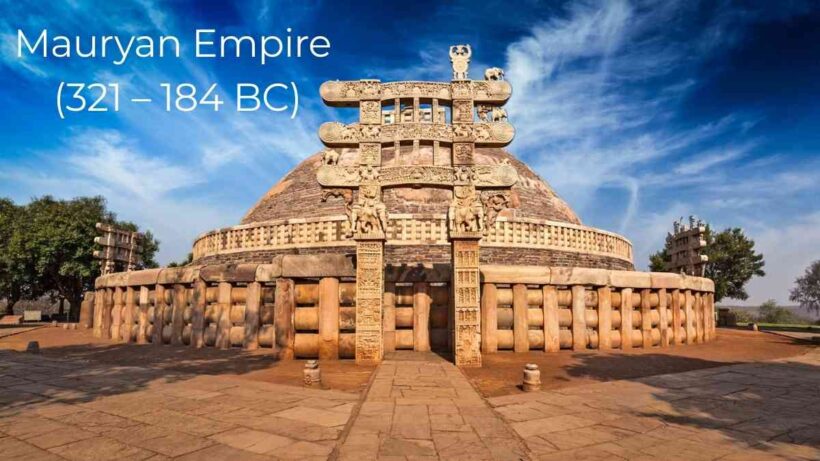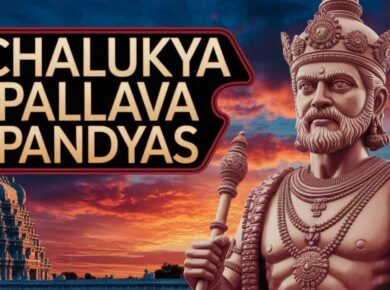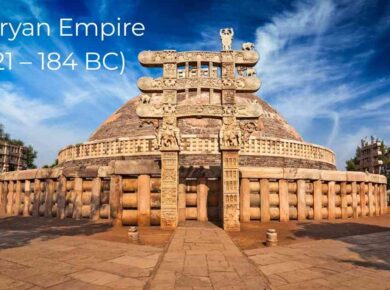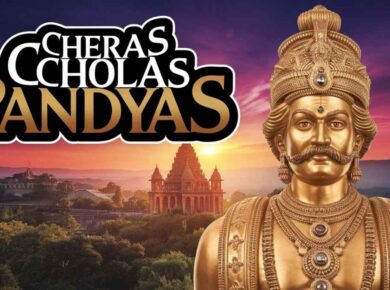Mauryan Empire (321 – 184 BC)
Literary Sources
Kautilya’s Arthshashtra
- Written in Sanskrit by Chanakya / KauFtilya / Vishnugupta / Indian Machiavelli
- Contains 15 books & 180 chapters; with main theme divided into 3 parts
- King & his council and departments of government
- Civil & criminal law
- Diplomacy of war
Vishakadatta’s Mudrarakshasa
- A drama in Sanskrit written during Gupta’s period
- Describes how Chandragupta Maurya with the help of Kautilya overthrew Nandas
- Gives socio – economic picture of condition under Maurya
Megasthene’s Indica
- Megasthene was a Greek ambassador in court of Chandragupta Maurya
- His book is survived in fragments & provides detail about Mauryan administration & military organization, particularly of capital city (Patliputra)
Ceylonese Chronicles
- Ceylonese chronicles “Dipavamsa & Mahavamsa” throw light on Ashoka’s role in spreading Buddhism in Srilanka
Edicts of Ashoka
- Inscriptions of Ashoka were 1st deciphered by James Princep in 1837
- Brahmi scripts were used for writing edicts, particularly Pali & Prakrit.
- In N-W India Ashoka’s inscriptions were also found in Kharosti script
- Name Ashoka occurs only in few minor edicts (Maski & Girnar) (In Karnataka & Madhya Pradesh), rest at all places edicts mention him as “Devampriya Priyadasi” > Dear to Gods
- Famous Sanchi Stupa & Sarnath Pillar constitutes to Ashoka’s rein
Chandragupta Maurya
- Founded Mauryan Empire by defeating Nandas with the help of Kautilya.
- In 305 BC, he marched against Selucus Nikator (Alexanders general controlling NW India) & defeated him.
- A treaty was signed, according to which, Selucus gave Chandragupta eastern Afganisthan, Baluchistan & area west of Indus & in return Chandragupta gifted 500 elephants to Selucus & married his daughter.
- Megasthenes was sent to Mauryan court as a Greek ambassador
- Greek writer Justin (Who wrote epitome) called Chandragupta “Sandrocottus”
Chandragupta embraced Jainism towards the end of his life & stepped down from the throne in favour of his son Bindusara & went to Mysore along with Jain monks led by Bhadrabagu & starved himself to death.
Bindusara
- Was called “Amitragatha” > Slayer of enemies by the Greeks
- Conquered Deccan upto Mysore
- Nikator’s successor Antichus 1 replaced Megasthenes with Deimachus as a Greek ambassador at Mauryan court under Bindusara’s Patronage
- Bindusara appointed Ashoka as the governor of Ujjain
Ashoka
- Victorious war with Kalinga was the most important event of Ashoka’s reign & its effect on Ashoka has been described by Ashoka himself in rock edict 13.
- As an effect of kalinga war, Ashoka embraced Budhhism under the influence of Buddhist monk “Upagupta / Mogaliputra Tissa”.
- Abandoned policy of physical conquest in favour of policy of cultural conquest (Bherigosha replaced by Dhammagosa) as mentioned on rock pillar 13.
- Appointed a class of administrative officers known as “Rajukas” vested with the power of rewarding & punishing people, wherever necessary
- Set up a very high ideal for himself as Paternal Kingship (Father of all)
Ashoka & Buddhism
- Ashoka’s conversion to Buddhism was gradual not immediate as he first became a sakya upasaka (Lay disciple) & 2 ½ years later became a bikshu (Monk) & gave up hunting
- Constituted Dhamma yatras to Sarnath, Bodhh Gaya etc. & appointed special officers called Dhamma Mahamantras to propagate Dhamma among various social groups
- Sent his son Mahendra & daughter Sangamitra to Srilanka who planted branches of original Bodhi tree there
- Convened 3rd Buddhist council at patliputra to strengthen sangha
Ashoka’s dhamma was to preserve the social order & held that if people behaved well they would achieve heaven. He never said they would attain Nirvana which was the primary aim of Buddhism. Hence, his teachings were intended to maintain social order on the basis of tolerance & does not seems to have preached any sectarian path
Ashoka’s Dhamma as mentioned in his various edicts may be summoned as follows:
- Service to father & mother, Reverence to teachers, Practice of ahimsa & love of truth
- Prohibition of animal sacrifices & slaughter, Prohibition of festive gathering for meaningless rituals
- Humane treatment of servants by the masters & prisoners by the governmental officials
- Courtesy to relations & liberty to Brahamanas with tolerance towards all religious sects
- Conquest through Dhamma instead of war
- Kandhar inscription speaks of success of his policies as hunters & fisherman gave up hunting & killing & began practicing agriculture
- Ashoka’s death was followed by division of Mauryan Empire into 2 parts Western & Eastern.
- Western part was collapsed by Bactrian invasion & Eastern part last king was assassinated by Pushyamitra Sunga
Also read: Jainism and Buddhism and Mahajanapadas Rise of Magadha
Mauryan Administration
Central Government
- Monarchy was supported by Kautilya however he did not stand for royal absolutism & advocated king to take advice of his ministry in running the administration
- A council of ministers called mantriparishad assisted the king in administration matters ( COM consisted of Purohit, Mahamantri, Senapati & Yuvraj)
- Civil servants known as “amatyas” were appointed to look after day-to-day administration & their selection method was given by Kautilya
Revenue Department
- “Samharta”, the chief of revenue department was incharge of collection of all revenues of the department
- “Sannidhata”, Chief custodian of state treasury & store house
Commerce & Industry
- Commerce & industry (Custom duties, foreign affairs, Weight & measure etc) was controlled by officers known as “Adhyakshas”
Judiciary
- Judicial chief justice of Supreme Court at capital in mauryan times was known as “Dharmadhikari”.
- Subordinate courts were under Amatyas & jails under appointed officers
Provincial & Local administration
- Mauryan Empire was divided into 4 provinces with capitals at:
- Taxila
- Ujjain
- Suvarnagiri
- Kalinga
- Provincial governors were appointed from the royal family
- District administration was under the charge of “Rajukas”, who in turn were assisted by “Yuktas” or subordinate officials
- Village administration was in hand of “Gramani“ and his official supervisors called “Gopa” (Head of 10 – 15 villages)
Art & Architecture
- Use of stone to make monuments started in time of Ashoka
- Highly polished, monolithic, slightly tapering rock pillars & highly polished caves (for monks)
- Sarnath Pillar: 4 lions standing back-to-back with small lion, elephant, bull & horse in circle
- Barabar hills near Bodh Gaya were presented to Ajivikas by Ashoka & his son Dasratha forms wonderful piece of mauryan architecture
- Introduction of burnt bricks to make structures & ring wells along with use of spoked wheel for the 1st time after Indus valley civilization
- Abundance of pottery NBPW & punch marked coins were found of Mauryan era
- May be art of making steel started & spread by Mauryas
Cause of fall of Mauryan Empire
- Ashoka’s pro Buddhist policies along with prohibition of sacrifices & rituals antagonized Brahamanas who brought about a revolution led by Pushyamitra Sunga
- Weak successors, Partition of empire, administrative abuses by Dustamatyas (Heavy taxex) after Ashoka’s reign led to the fall of empire
- Widespread use of iron led to formation of new kingdoms & neglection of N-W front by Mauryan also led to their downfall
- Chinese ruler “Shih-Huang-Ti” constructed great wall of China to prevent its border against sythians who an Iranian equestrian tribe were, but Mauryan did not do any such thing
- Pushyamitra sunga (Brahamana) killed last Mauryan emperor Brihadratha publicly & persecuted Buddhists and restarted Vedic rituals & sacrifices.
For more updates, explore the IR & Security Category. Feel free to share your thoughts and comments
If you’re passionate about building a successful blogging website, check out this helpful guide at Coding Tag – How to Start a Successful Blog. It offers practical steps and expert tips to kickstart your blogging journey!












2 comments
Very good and basic information in details about Mauryan Empire.
good and helpful information about Mauryan Empire